Nose in the Air
Professor Allen Goldstein’s mobile machine sniffs out the atmosphere’s secrets

Also...
Nutrients that talk to your brain
Research Journal: L.A.’s mass transit

Professor Allen Goldstein’s mobile machine sniffs out the atmosphere’s secrets

Also...
Nutrients that talk to your brain
Research Journal: L.A.’s mass transit
If you’re like most UC Berkeley graduates, there’s at least one Cal professor who stands out in your memory—a close mentor, an inspiring teacher, or perhaps a scientist who made your head spin.
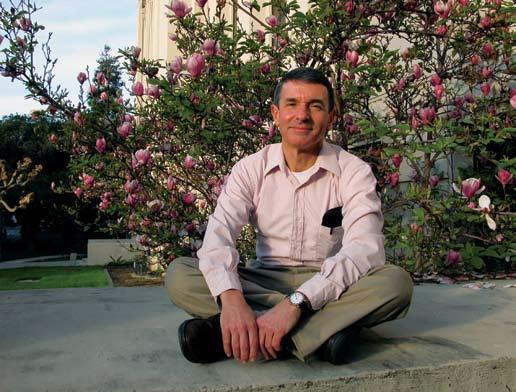
Berkeley’s scholarly reputation rests on the quality of its faculty. But, unlike institutions such as Stanford, Harvard, and Yale, which typically recruit established scholars, Berkeley focuses on hiring individuals who are early in their careers and show great promise. These scholars arrive as untenured assistant professors. To earn tenure, they must prove their teaching ability, offer service to the campus and their profession, and most importantly, publish, publish, publish great research. It’s a heavy burden to bear.
So why do it? Tenure is about much more than job security. It offers scholars freedom to explore, to be creative and original, and to follow any line of research wherever it may lead. And tenure at Berkeley offers another intellectual treasure: the opportunity to interact with some of the most terrific undergraduates, graduate students, and other scholars in the world.
At CNR, we are successful at “home-growing” our faculty because we commit considerable resources to the task. This includes funding the start-up of laboratories, making sure every young scholar has an experienced mentor, and providing rich opportunities to develop and share ideas with colleagues from different departments.
This year alone we’ve made 10 stellar additions to the faculty. (You’ll meet some of them on pages 10-11.) These new professors promise to carry on CNR’s tradition of excellence, and I have every confidence that they will leave the same lasting impression on today’s undergraduates that your favorite professors left on you.
Fiat Lux, Lew Feldman Associate Dean, Academic Affairs
J. Keith Gilless EDITOR
Cyril Manning
NOSE iN THE AiR by Nathanael Johnson
Prof. Allen Goldstein’s mechanical nose analyzes compounds in the atmosphere’s soup.
GUT FEELiNG by Kathleen M. Wong
A key discovery finds nutrient molecules that send messages to the brain.

Letty Brown
Nathanael Johnson
Stephanie Ludwig
Daria Mazey
Robert Sanders
Erica Spotswood
Kathleen Wong
Sarah Yang
New ranking system puts CNR on top CNR professor wins “genius” award Pacific treefrog mutations show surprising origins
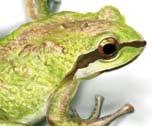


Could Kyoto work after all?
Gene expression helps refine water monitoring
Participatory research comes to Northwest forests
Three new microbes discovered in mine slime Algorithms beat labwork in deciphering proteins ...and
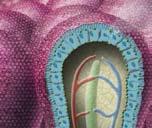
PhOTOGRAPhy AND
Michael Barnes
James Block
Brett Boltz
Ed Carreon
Steven Chan
Nicolle Rager Fuller
Jack Gescheidt
Logan Parsons
David Schmitz
Genevieve Shiffrar
Warnow
Designer: Ron Addad

I was surprised to read the article “Can farmworkers afford the food they grow?” in Breakthroughs (Winter 2007). It is another application of the often-used reactionary ploy of “blame the victim.” Farm workers are not more ignorant than the rest of us who consume the products of their strenuous backbreaking labors.
I have participated in several similar human behavioral and attitudinal surveys and have been interested in farm labor issues since the 1950’s Mexican Bracero programs. Conclusions should not be reported based on sketchy or incomplete returns. Survey data, especially attitudinal responses, should be carefully scrutinized to make certain that they reflect accurately the real situation and are not simply anecdotal in nature.
To accept the validity of the “survey,” what is the implication for the reader but that the unfortunate survey respondents are both intellectually and informationally impaired.
—Masao Matsumoto, ’61 (M.S.) and ’68 (Ph.D), Agricultural and Resource Economics
Cooperative Extension Specialist Christy Getz responds:
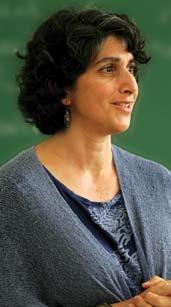
Our assessment of farmworker food security in the Central Valley included in-depth surveys with 454 farmworkers. Our goal was to understand how structural vulnerabilities, including eroding wages, seasonal unemployment, and language and cultural barriers, affect farmworkers’ ability to access and afford nutritious, culturally-appropriate food. Our sample is not representative of the entire farmworker population; however, we do attempt to move beyond anecdotal evidence to paint a more complex picture. We found, for example, that 45 percent of the farmworkers in our sample do not have access to sufficient quantities of nutritious, good quality food. We also found that both low income levels and undocumented immigration status are significantly (and independently) correlated with high levels of this food insecurity. We are currently working with stakeholders in the Central Valley to improve farmworkers’ access to affordable and nutritious food.
We want to hear from you!
e-mail your letter to the editor to breakthroughs@nature.berkeley.edu, leave comments on any article in our online version at http://nature.berkeley.edu/breakthroughs, or put pen to paper and mail it to:
University of california, Berkeley
Breakthroughs editor
101 Giannini Hall #3100
Berkeley cA 94720-3100
M easuring greatness Berkeley academics often greet college rankings with a healthy dose of skepticism—despite occupying top slots year after year. That’s because most rankings are based more on reputation than any real measure of excellence.

But a relatively new ranking system called the “Scholarly Productivity Index” may provide a more credible measurement. Assessed by the private company Academic Analytics, this index bases its results on serious data, including faculty publications, federal-grant dollars awarded, and honors and awards.
The results, published early this year in The Chronicle of Higher Education, are no surprise: The faculty of CNR’s doctoral programs ranked among the highest in their fields—and CNR’s plant biology faculty was named the most productive in the nation.
—Cyril ManningA cross six disciplines , cnr f A culty were r A nked A mong the top in their fields n A tion A lly .
Botany and Plant Biology: #1
Toxicology: #2
Agricultural Economics: #3
Microbiology: #3
Nutrition: #3
Environmental Science: #4
C laire K re M en is u C B er K eley ’ s newest M a C a rthur F ellow .
An assistant professor of environmental science, policy, and management, Kremen received the $500,000 award for her pioneering conservation work in Madagascar as well as her recent studies of bees and other natural pollinators, and their critical role in the global human food supply (see “Going Native,” Winter 2007).
MacArthur Fellowship awards come with “no strings attached,” allowing awardees to accelerate their current activities or take their work in new directions.
Says Kremen: “Winning the award is like having a gauntlet thrown down before you—saying that you did well, but what are you going to do next?”
M utant F rogs t ell a ll

No, it isn’t from radioactive waste: research conducted by a CNR ecologist indicates that the cause of these mutations is a trematode parasite called Ribeiroia
A tiny parasitic flatworm, Ribeiroia ondatrae is first hosted by aquatic snails, and then released at night essentially to melt through the skin of tadpoles. As these tadpoles grow, they typically exhibit extra, missing, or malformed limbs. And if the parasite itself does not kill the frogs, the mutations it can cause often make it much more difficult for them to escape birds and other predators.
Kevin Lunde, a graduate student in the Department of Environmental Science, Policy, and Management, has been conducting research on frog mutations since 1998. He has found that almost 50 percent of Pacific treefrogs at the Hopland Research and Extension Center were affected by Ribeiroia. Although some Ribeiroia in nature is harmless, current research and museum records indicate that it is becoming increasingly common. In a paper Lunde co-authored in a 1999 issue of Science, researchers found that fewer than 2 percent of infected frogs in a given pond reach sexual maturity, creating a sharp decline in frog populations.
The question remains whether this increase in Ribeiroia abundance can be attributed to humans. Lunde says that although wide-scale tests have not been conducted, the evidence he’s seen suggests that humans are playing a significant role. Human addition of nutrients such as nitrogen and phosphorus into the frogs’ habitats causes an increase in algae, which in turn creates booming snail populations and more hosts for Ribeiroia. “Wetland loss is another contributing factor,” he says. “Over 90 percent of California’s wetlands have been lost to development. This forces water birds who have consumed the infected frogs onto eutrophic land,” where nutrient-rich waters offer perfect conditions for the further spread of Ribeiroia
The problem is not limited to treefrogs. “This parasite causes limb malformations in numerous species of amphibians across the western United States,” says Lunde. His continuing investigations will focus on the roles that light, temperature, and nutrients play in expanding populations of Ribeiroia’s snail hosts.
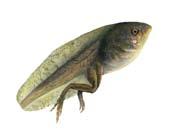
 —Stephanie Ludwig
—Stephanie Ludwig
The trees of Berkeley have always been powerful symbols—and not just to CNR’s Forestry alumni. This year, one of campus’s most recognizable trees and several of its most controversial ones played starring roles in two very different, high-profile photographs. And not surprisingly, two distinct strands of Berkeley passion and intellect were intertwined with these trees’ branches.

In January, a crew from Vanity Fair posed six of UC Berkeley’s seven living Nobel Prize winners, along with Chancellor Robert Birgeneau, on and around the Faculty Glade’s ethereal California buckeye. The magazine’s crew was on campus for a lecture in which the Nobel laureates (from left: Yuan T. Lee, Donald Glaser, Daniel McFadden, George Smoot, Charles Townes, and Steven Chu) spoke passionately about global warming and energy sustainability. UC Berkeley’s Michael Barnes captured the moment in the image, above; Vanity Fair’s take appeared in the magazine’s May 2007 “Green Issue.”
F inding your B arings In March, San Francisco photographer Jack Gescheidt recruited 78 models to bare all for the making of “Last Stand,” above. Gescheidt was inspired by Save the Oaks activists who have long protested University plans to remove a number of trees as part of the Memorial Stadium renovation and Student-Athlete High Performance Center construction. Says Gescheidt: “I made this photo in the grove to help as I could with consciousness raising about the huge value of those oaks in so many regards, as well as of mature trees everywhere in our midst.”
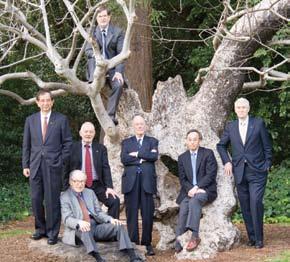
a B ated B reath Back in 1997, many hoped that the Kyoto accords would be the final word on global cooperation to stop climate change. But with the refusal of key nations—most notably the United States—to sign on, this landmark protocol of the United Nations Convention on Climate Control has produced more controversy than results.

The future of the accords became an even greater question during last summer’s G8 Summit. There, President Bush pegged his first significant acknowledgment of the need to address global warming to a proposal to start an entirely new round of negotiations, outside the framework of the United Nations.
But Professor Larry Karp, chair of Agricultural and Resource Economics, casts doubt on the impulse to start from scratch. “Kyoto is the only game in town,” he says. “We need to be thinking about how to modify it.”
In a recent Giannini Foundation working paper, Karp and co-author Jinhua Zhao of Iowa State University propose amending Kyoto to allow signatories to pay a fine as an alternative to meeting abatement goals. Such a fine, he says, would offer nations insurance against the potentially high costs of decreasing emissions. The money collected from nations who do not meet their emissions goals would be paid out among all signatories. Together, the cost ceiling and payout should make ratification of the treaty more attractive to everyone. Even better, Karp’s plan would also give the Kyoto agreement some teeth, allowing the U.N. to actually enforce it. In theory, this system would also give new signatories the clout to pressure fine-paying nations toward abatement. Karp poses a theoretical example: “Suppose that there are initially 10 members and that the nominal fine is $100. If a signatory decides not to abate, it pays $100. All signatories get an equal share of that fine. That’s a $10 rebate, which makes the cost of not abating $90. Now, suppose that a new country joins: the rebate for everyone is now $100 divided by 11, so the cost of not abating increases to about $91. This may seem like a small increase, but each of the signatories faces this increase, so the effect of it on the aggregate level of abatement can be large.”
—Stephanie Ludwig By the NumBers77 Years of continuous maintenance of the Giannini Library’s old-school card catalog (also available on the Web at http://are.berkeley.edu/library)
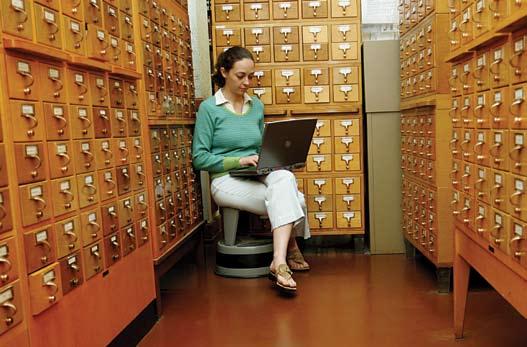
466
72,000
Number of ARE Ph.D. dissertations on file in the Giannini Foundation Library, (including one penned by iconoclastic economist John Kenneth Galbraith ‘34)
Approximate number of ARE working papers downloaded from the eScholarship digital archive (http://repositories.cdlib.org/are_ucb/) since its inception in 2002
3
Prestigious awards received by Assistant Professor

Max Auffhammer over the span of four days in early 2007, including the Sarlo Distinguished Graduate Student Mentoring Award, the CNR Young Faculty Award, and the Proceedings of the National Academy of Sciences Paper of the Year Award
140
45
3.25
8
Approximate number of students pursuing ARE’s undergraduate major, environmental economics and policy (EEP)
Approximate number of EEP students enrolled through CNR’s partnership with the College of Letters and Sciences
Number of ARE graduate students per faculty member
Number of water resource management projects supported by the Berkeley Water Center, a partnership directed by ARE professor David Sunding that includes the College of Engineering and the Lawrence Berkeley National Lab
Graduate student researcher Helen Poynton takes samples from the frigid water of little Grizzly creek. located in Plumas national Forest, the area is highly contaminated with copper from Walker mine. Back in Berkeley, researchers exposed water flea specimens (Daphnia magna) to the toxic water and then examined the organisms’ gene expression.

s ave the B ugs It’s pretty common for regulators to use the tiny water flea Daphnia magna to monitor freshwater toxicity. The organism is highly sensitive to contaminants in its environment, so counting dead water fleas can give investigators a decent sense of water quality.

However, this not-so-subtle “kill ‘em and count ‘em” technique doesn’t explain exactly how a toxicant is affecting the organism. Now researchers from nutritional sciences and toxicology have found a better way: by looking at characteristic changes in the organism’s gene expression. Graduate student Helen Poynton and her mentor, associate professor Chris Vulpe, published their findings last winter in the journal Environmental Science & Technology
“The extra information we get from looking at gene expression could help us make more informed decisions about how harmful a toxicant is,” says Poynton. “It could give regulators a new direction that we should be pursuing in monitoring water quality. For instance, we could find that it’s necessary to regulate toxicant levels at lower levels, so we can act before toxicants get to the level of actually killing a population.”
Toxicogenomics could also be used for chemical screening, the researchers say. “For those in industry, chemicals could be screened for potentially ecological consequences while they are still in development,” said Poynton. “In pursuing 10 different chemicals for one application, it may be discovered that one is particularly toxic, so it can be ditched right away. At the same time, if screening reveals that there is little or no impact on gene expression from a particular chemical, why not pursue that one for commercial development?”
—Adapted from an article by Sarah Yang
F riendly F ellows The old-fashioned natural scientist spends long, solitary days collecting samples in the field, returning to a lonely laboratory to evaluate specimens, and publishing results in isolation. The Community Forestry Research Fellowship (CFRF) aims to create a new model. Funded by the Ford Foundation, this UC Berkeley fellowship for urban and rural forestry students from institutions around the country supports and spreads a practice known as participatory research. Participatory research engages community partners in the study of their surroundings. Community members are brought together to share knowledge and improve the way resources are managed. By utilizing local knowledge, researchers gain a deeper understanding of their study sites, resulting in improved experimental design and more useful results.
Heidi Ballard, a 2001 CFRF Fellow who is now an assistant professor of environmental education at UC Davis, believes her fellowship project was a textbook example of this approach. Ballard, who earned her Ph.D. in environmental science, policy, and management, studied the harvesting of “salal” in the forests of the Pacific Northwest. Salal is the rich green backdrop used in fine floral arrangements. It grows exclusively in the U.S. and is exported throughout the world, yielding millions of dollars in yearly revenue.
Ballard found that lax regulation and poor communication between harvesters—often migrant workers—and landowners have threatened the sustainability of the salal harvest. “Instead of using college undergraduates as field assistants, as most studies do, I asked harvesters with local knowledge to work with me,” Ballard explains. “We collaborated on the methods at a level I had not anticipated. This incredible potential for participatory research had been previously unknown to me.” The benefits of her work are still felt today in these communities, in the form of improved communication between harvesters, landowners, and the Forest Service.
While the Community Forestry Research Fellowship program continues to thrive at CNR (which is supporting seven fellows this year alone), Ballard now teaches a course in participatory research at UC Davis.
—Letty Browne xtre M e s C ien C e For 11 years, Jill Banfield has collected and studied the microbes that slime the floors of mines and convert iron to acid, a common source of stream pollution around the world. Imagine her surprise, then, when research scientist Brett Baker discovered three new microbes living amidst the bacteria she thought she knew well—smaller than any other known cellular life form.
“We were essentially looking for new stuff,” says Baker, “and we found it.” Banfield, a professor of environmental science, policy, and management and of earth and planetary science, has been trying to understand how such extremophiles—microbes that live in extreme environments—live together and generate the acid drainage that makes such mines toxic hazards.
The collaborators have been using advanced genetic sequencing techniques to identify newly discovered microbes—both bacteria and a type of organism known as Archaea. When Baker turned up the three Archaea from a totally unknown group, he was able to fish the microbes out of the slime soup and measure their diameter at about 200 nanometers. As The New York Times reported, “four million of the newly discovered microbes could fit in the period at the end of this sentence.”
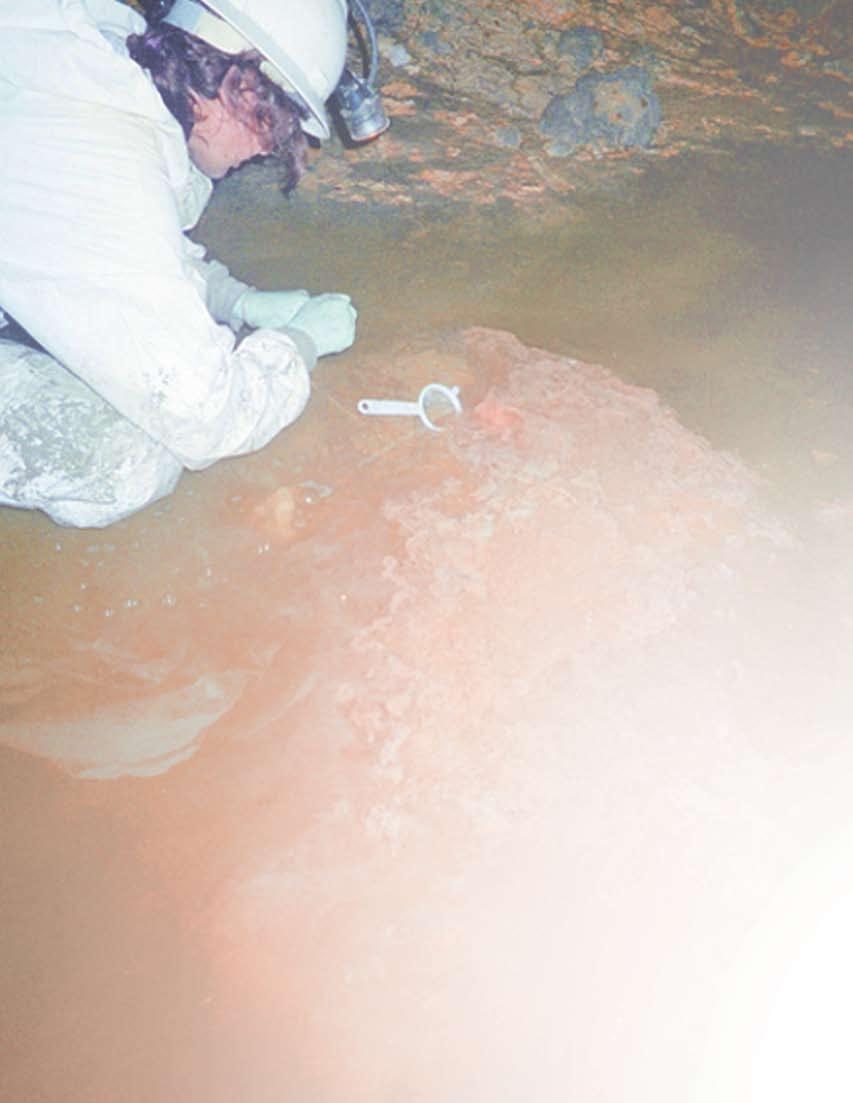
All of which means that, as the researchers put it when they published their discovery, “It may be necessary to reconsider existing paradigms for the minimum requirements for life.”
—Adapted from an article by Robert Sanders
three enigmatic Archaea plucked from a pool of pink scum, in california’s Richmond Mine. transmission electron micrograph (teM) images like these show that most have protrusions (B), dark areas that probably are packed ribosomes (c), and unidentified dark inclusions (d). the 100 nanometer scale bar is approximately one-thousandth the width of a human hair.
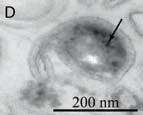
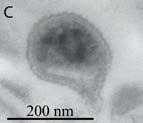
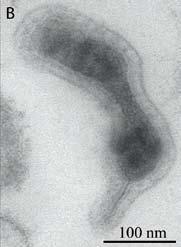
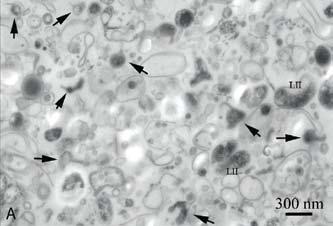
g ene M a C hine Biologists are knee-deep in protein sequences. Thanks to automation, genes that code for proteins are being found with ever-increasing speed. But deciphering what these proteins do—the logical next step in the process—remains a daunting hurdle.
When genetics was new, time-consuming lab experiments were the only way to determine what proteins did. Today, scientists routinely search giant databases for similar protein sequences that might help predict a new protein’s function.
By rights, such automated matching should make protein function prediction a snap. But the process isn’t nearly so simple. Like the organisms they come from, proteins evolve over time. As a protein’s gene mutates, that protein’s function will eventually shift, too. Compounding these issues are database errors, where protein functions were entered incorrectly, or were based on faulty database matches. Mistakes are then copied over as new proteins are added, leaving databases riddled with inaccuracies.

The problem came to a head in 1995, when the genomes of bacteria were being sequenced for the first time. Using combinations of automated searches and personal expertise, several groups of researchers claimed conflicting functions for Mycobacteria genitalium’s fewer than 500 genes.
Associate Professor of Plant and Microbial Biology Steven Brenner aims to straighten out this mess. Along with graduate student Barbara Engelhardt and computer science professor Michael Jordan, Brenner is developing a new approach to protein function prediction. It bridges the pitfalls of previous prediction methods with logical, thoroughly annotated, and statistically-based assessments.
“We’ve taken all of the steps involved in manual phylogenomics, a method of predicting the functions of proteins based on the evolutionary history of their genes, and begun to automate them,” Brenner says. “We’re developing ways to take the detailed insight of a human expert and are beginning to apply it in a systematic way on a large scale.”
Called SIFTER (Statistical Inference of Function Through Evolutionary Relationships), the program automates phylogenomics. After searching existing databases for related genes, it arranges any hits into a family tree. Branches are arranged based on similarities in sequence and function, while each leaf shows an individual protein’s function when available, plus what that prediction was based on—a lab experiment, a statement in a scientific paper, or (in the least accurate case) an inference from a database.
The program then calculates how easily proteins in this family shift functions by looking at the tree. This information allows SIFTER to assign a confidence rating to each function prediction.
“SIFTER gives traceable evidence; it tells you not just what it thinks the function is, but why and how much confidence you should have in that prediction,” Brenner says.
In tests with known families of proteins, SIFTER has performed impressively well. “It turned out we did better than anything else out there, with 96 percent correct,” Brenner says. Even in more complex families, where the proteins have more functions and evolve in less predictable ways, SIFTER was correct 60 percent of the time, compared to 40 percent success for the method that’s currently the most widely-used. Though SIFTER remains a work in progress, its early results forecast a prominent role in the phylogenetics of the future.
—Kathleen Wongt op F ive Nancy Amy, associate professor of nutrition, teaches the most popular course on campus: Introduction to Human Nutrition. Given the high demand for her expertise, Breakthroughs asked Amy to share five key lessons that she hopes will stick with her students—and with you:
1 2 3 4 5
Have fun with food. i t’s a legal pleasure, appropriate for all ages. Try new things: different types of foods, different spices, different ethnic foods.
There are many different types of healthy diets. The bottom line is that good nutrition is important for everyone: young and old, sick and healthy, athletes and bookworms, dieters and people who never have to think about their weight.
Be skeptical about nutrition claims. Get information from good sources, and avoid self-proclaimed health gurus who claim they have found the secret to health or weight loss.
Nutrition is science, not science fiction. There are no magic foods, no magic diets, and no secret formulas.
What you eat is only half the picture. You need to use the energy from that food. Go out and play.
For a full semester’s worth of nutrition wisdom, download Amy’s lectures from Introduction to Human Nutrition. Find the podcasts at http://nature.berkeley.edu/breakthroughs.
Lisa Forma, winner of the 2007 Babcock Prize and a finalist for the prestigious University Medal, first started at Cal in 1971, dropping out after 10 weeks. She returned when her UC Berkeley-bound daughter Lizzie was a senior in high school.
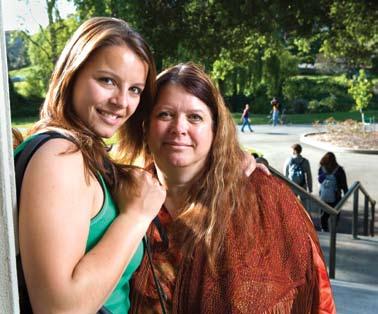

Attending CNR at the same time, Lisa majored in Conservation and Resource Studies and joined the Boyer hydrology Lab, while Lizzie pursued Molecular Environmental Biology. “Lizzie was an incredible support to me academically,” says her mother, “balancing sympathy with ruthless ‘c’mon, mom, get to work on that paper!’”
Lisa had vowed to give her daughter plenty of space, but says, “She let me come over to watch ‘America’s Next Top Model’ with her and her roommates, and wasn’t even embarrassed.”
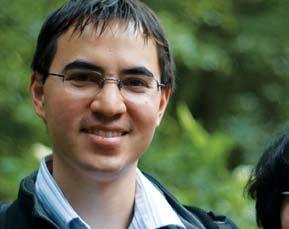
As a health economist, I work on the ‘health production function’—that is, looking at the factors that determine health outcomes. For example, I’m interested in the relationship between social status and health, and I recently published a paper showing that workplace promotions can reduce that probability that a worker develops heart disease. It turns out that differences in health-care spending, and even access to care, explain very little of the overall variation in health outcomes. So the most important determinants of health are likely to be social and environmental factors.
As an environmental lawyer in Australia, I used to help companies figure out if they met environmental regulations. I’d go to factories, wear a yellow helmet and look around; I learned a lot about the nitty-gritty of manufacturing that later inspired my research. It led me to the field of green chemistry, which means working to cut the toxic chemicals found in countless consumer products. I think we need a mix of regulations to force industry to improve, innovative tools that companies can use to screen their products, and far more information on what products contain so that consumers can choose greener products.


The current pace of discoveries in the biomedical field is unprecedented, and it is thrilling to be a part of this rush. I am particularly intrigued by the question of how obesity can cause so many different ailments. I use molecular and genetic approaches to study the mechanisms underlying the link between metabolic deregulation and diseases such as diabetes, liver disease, cancer, and others. At professional meetings, I frequently talk about a group of fat-transporting proteins that I discovered as a postdoctoral fellow at MIT, and their role in human diseases. But as a nutrition researcher the most frequently asked question I get asked from a general audience is: ‘Does the ___ Diet really work?’
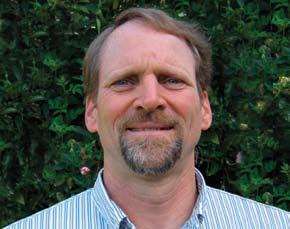
After spending 10 years conducting and managing research for the California Department of Forestry and Fire Protection, I moved back to Berkeley as a forestry specialist with Cooperative Extension. It’s a great opportunity to work with a broad array of Californians, at a time when outreach is especially important. The spread of new homes into the wildlands is changing the practice of fire management. It is a challenge to engage landowners as ‘backyard’ land managers who must also be part of the solution. Finding techniques to get the messages across to residents may be as important as the technical details.
Neil Tsutsui, assistant professor
My research focuses on the evolution and behavior of ants, which are interesting for a variety of different reasons. They form complex societies that cooperate, have division of labor, fight wars against each other, and enslave each other. They are very, very ecologically successful. And they are diverse—there are predators, parasites, farmers, and species that will eat anything and live anywhere. Invasive species, such as the Argentine ant, can cause serious economic and agricultural problems. They can also cause a cascade of ecological problems—for example, species such as horned lizards and native plants often depend on native ants for survival, and suffer when Argentine ants kill off the natives.
Daniel Zilberman, assistant professor Plant and Microbial Biology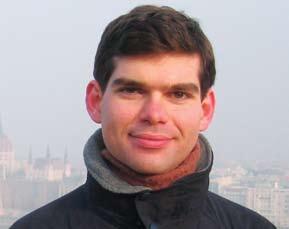
The basic approach of genetics is breaking stuff to figure out how it works. That’s intuitive and appealing to students. We tend to focus on living organisms as individuals, but life is continuous—every creature alive today is descendent in unbroken succession from a single ancestor. The story of life is written in DNA. I believe that by sequencing and understanding the genomes of many species, from the mundane to the bizarre, we will understand life and our place in it.


 By Nathanael Johnson
By Nathanael Johnson
When graduate students working with biogeochemistry professor Allen Goldstein first took the readings from the machine they had built, they weren’t prepared for what they saw. They had hoped it would pick up minute chemicals in the air—they just hadn’t expected to see such a vast array of compounds.
Goldstein’s crew had designed a mechanical nose: a machine that could pick compounds out of the air with enough precision to tell researchers where they were coming from—to differentiate not just between particles and ozone, but to separate particles coming from car exhaust and diesel emissions. Scientists already had the ability to make these fine distinctions, but the typical process of taking an air sample in the field and later analyzing it in the lab was very slow and expensive. This nose would breathe: sucking in the air and analyzing compounds on the fly.
They had been tinkering with it in a room in hilgard hall and it seemed to be working, so they decided to try another location. The team collected a few samples in West Berkeley. The



neighborhood they chose is a bit scruffy—a mix of old Victorian cottages and modern industrial buildings just behind Aquatic Park. They hadn’t picked that location for any particular reason; it just happened to be where Aerosol Dynamics, Inc., a company collaborating on the project, is located. When they ran the samples, the results were remarkable. The machine took smells and made them visible. “We could see the traffic from the morning commute,” Goldstein says, “and we could see caffeine in the air when the coffee shops were roasting.”
But what was most amazing was that the system was picking up far more compounds than they had expected to see—from tree emissions to nicotine smoke to a variety of illegal drugs.


The point all along had been to turn the ebb and flow of invisible compounds into a legible printout. The analysis displayed a whole world of hidden acts in crisp focus.
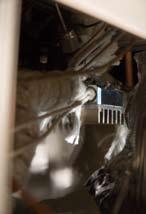
The machine is known as TAG—an acronym so complex it contains another acronym. It stands for thermal desorption aerosol GC/MS-FID (that is, gas chromatography/mass spectrometry—flame ionization detection). TAG rolls off the tongue a little easier. Goldstein fondly refers to his crew as “the TAG team.”
The TAG system was never meant to detect drugs. Goldstein and his team developed it because they had larger questions to answer, and didn’t have the tools to do it. So they created the tools themselves.
Goldstein, chair of the Department of Environmental Science, Policy, and Management, is a cleancut man who has the look of someone for whom function routinely trumps form. As an undergraduate at UC Santa Cruz in the 1980s, Goldstein majored in both chemistry and politics. “From the beginning there,” Goldstein said, “I was interested in working on fundamental science that could give us the information needed to make sound policy decisions.”


So, what is thermal desorption aerosol gas chromatography/mass spectrometry–flame ionization detection, anyway?
This theme runs through Goldstein’s work, which is otherwise wide-ranging. he’s worked with the National Oceanic and Atmospheric Administration (NOAA) to track global pollution flow, recorded forests breathing to understand their carbon uptake, updated the science on emissions from cattle (it turns out they produce fewer ozone-forming pollutants than previously thought), and analyzed the particles blowing into Riverside from los Angeles to find out what they are and where they’re coming from. he’s also likely to play an important role in Berkeley’s new Energy Biosciences Institute, looking at the potential effects that new biofuels could have on the atmosphere. It’s all work that can affect the course of politics and policy.
Goldstein is particularly interested in organic compounds in the atmosphere —that is, compounds built around carbon atoms. Organic compounds, though they make up far less than one percent of the atmosphere, are important. Some are toxic and cause cancer if inhaled in high concentrations. Some react with other gases to form ozone and particles affecting both human health and the earth’s climate. “you can’t understand air pollution,” Goldstein says, “until you understand what’s naturally in the atmosphere and how that is changed by human activities.”
We know a lot about the atmosphere, he says, but “when it comes to organic compounds, there’s much more that we don’t know.” In a recent
The TAG machine works by (1) collecting a sample for 30 minutes, then (2) compressing and
(3) slowly heating it from 85 to 660 degrees Fahrenheit. (4) One by one, the compounds vaporize, get separated according to their chemical properties, and fly into a chamber where they are bombarded with electrons. (5) The pieces from this blast form a distinct pattern —a sort of fingerprint— which the scientists use to determine what is in the air.

paper, Goldstein points out that if you look at all the organic compounds going into the atmosphere (aside from methane), 90 percent are emitted directly by natural plants, and we only know what happens to half of them. The other half must go somewhere—we just don’t know exactly where. In the same paper, he notes that the last comprehensive summary of organic compounds in the atmosphere listed a total of 2,857. Since then, scientists have identified some 10,000 others and, as Goldstein writes, “That may be only a small fraction of the number actually present.” The air, it turns out, is a great soup of compounds constantly jostling and reacting with each other.
This soup is a tricky thing to study. First of all, it’s big—too big to fit in a lab. The second problem is, it’s small—made up of components so tiny they are invisible. And finally, it’s fast—these compounds move around constantly. They are emitted en masse then float away, diluting into the soup. They transform in midair. To really be able to “see” the air you’d need a device that could move from place to place, that could tell the difference between thousands of tiny compounds and could do so quickly.
Atmospheric chemists already had machines that could analyze gases on the fly, but nothing that could detail what organic particles are made of as they pass by. Then, about five years ago, a colleague in the private sector, Susanne hering of Aerosol Dynamics, mentioned that her business had developed a tool to analyze the nitrogen and sulfur in particles, but could not differentiate the organic compounds. Goldstein approached her, and together they set out to build a system to combine their technologies—a portable machine that could quickly analyze particles, every hour, on location, and identify and quantify the organics present. The machine they developed together sucks air in, traps the particles, and analyzes the organics. Instead of taking samples back to the lab for analysis, the researchers take home data.



To test the machine, the team decided to give it a specific set of compounds that can only be created by burning wood—and see how it did. Dabrina Dutcher, who was working at Aerosol Dynamics at the time, created a fire and started collecting samples. When she ran the sample, she was elated—the machine gave a perfect reading for wood smoke. “It was like a miracle,” Dutcher said. “It just seemed too good to be true.”
With further tests and new ideas, the TAG team is continuously tweaking and improving their electronic nose, creating a system powerful enough to sniff out the sources of air pollution. And while those initial results from
West Berkeley are more interesting for their novelty than their scientific value, they were indicative of the TAG system’s potential. Almost anything that pollutes—a car running, a log burning, or someone cooking meat— will release a unique organic compound that the machine can identify.
When Goldstein and his team took TAG to Nova Scotia as part of a project to analyze global pollution flow, they were able to identify compounds from fires burning in Alaska. When one of Goldstein’s graduate students took measurements in Riverside, he found that a whole class of compounds in the particles blowing in from los Angeles were coming from the cooking of meat— a source of particle pollution that most people never even consider.
This is the kind of information that policy makers need if they have any hope of making meaningful change. By sniffing out the link between events on the ground and particles in the air, TAG could help regulators track down polluters and determine how to counteract the harmful effects of our emissions. “It’s very invigorating as a scientist to see what we’ve learned affecting public policy,” Goldstein says.
—Nathanael Johnson is a freelance writer and a producer for the public radio show “KALW News.”


A new class of clean, renewable transportation fuels derived from crops may be on the horizon. Two new research centers—the Energy Biosciences Institute, funded by BP, and the federally funded Joint Bioenergy Institute—locate Berkeley at the heart of this burgeoning field.
The potential of future biofuels to reduce carbon emissions and ease global warming is great. Less clear, however, is the effect they could have on air quality, says Allen Goldstein, professor of environmental science, policy, and management.
“Biofuels have the potential to be carbon-neutral, meaning that the carbon dioxide (CO2) emitted is equal to that taken up by plants,” Goldstein says. “But if biofuel production emits significant amounts of methane and nitrous oxide, we need to look at what those net effects will be for all the greenhouse gases, not just CO2.”
Butanol, for example, is “two to three times more reactive than ethanol and probably has different ozone and aerosol implications as far as air quality goes—so we need to understand the implications of using butanol in the fuel mix before we use it on a widespread basis.” The crops used to generate biofuels also merit study, Goldstein adds. Some feedstocks remove ozone from the atmosphere, for instance, while others emit ozone-producing hydrocarbons. Exploring all of these issues is critical to determining whether biofuels are a truly sustainable energy source.
Some critics of Berkeley’s bioenergy partnerships have voiced concerns that funding from BP will encourage development of profitable fuels without adequate investigation of their shortcomings. But by examining the potential pitfalls of emerging biofuels, Goldstein and many other scientists across campus are working to ensure we don’t solve our current atmospheric problems by creating new ones.


Hamburger doesn’t rank high on most health food lists. But chances are, a juicy bite of burger will do your body more good than simply fueling your cells. Since the 1920s, scientists have speculated that there is a sensory system that specifically detects the mere presence of fats, proteins, and other nutrients in the gut. Now, UC Berkeley Professor of Nutritional Sciences Greg Aponte has discovered a certain class of molecules that can act as intestinal sentinels. They respond to the presence of nutrients in the gut by sending a barrage of messages to the brain, immune system, and other body cells.
Aponte’s got his office-cum-laboratory equipped with a functional kitchen for his own use. A wall of herbal tea boxes lines one counter, while a mini-refrigerator, bottled water, and a microwave take up another corner. he acknowledges the collection with an apologetic smile. “We practically live here sometimes, so it’s good to have a few food supplies around.”
Whatever it is Aponte consumes, it’s kept him both trim and energetic. he explains that studying how the presence of foods affects the body helped him uncover a mechanism for an intestinal awareness system. “We traditionally think of nutrients as things that get absorbed. But there can be a lot of factors in nutrients that might affect your health and genetic response that don’t get absorbed,” Aponte says. “We’ve been interested in ways that nutrients can act as signal molecules, not as metabolic substrates.”
Aponte has been working with a widespread class of cell receptors called G-protein coupled receptors, or GPCRs. Found in the tongue, the eye, the nose, and the nervous system, these proteins are heavily involved in environmental sensing through taste, smell, and vision, as well as depression, euphoria, and pain control.
Because they open doorways into so many body systems, GPCRs are prime targets for drugs. Up to 40 percent of all pharmaceuticals interact with these proteins, adding up to a $60 to $80 billion-dollar-a-year business.
In the body, GPCRs bob about in the sea of fatty molecules that make up cell membranes. In structure, they consist of six sinuous bends plus a head and a tail that protrude above and below the surface of this sea; a GPCR in-situ bears an uncanny resemblance to that famed but bogus photo of Nessie the loch Ness Monster.
This serpentine structure endows GPCRs with multiple talents. The bends, head, and tail can serve as docking
Inside the small intestine, GPCRs (shown here in green) bob about in the sea of fatty molecules that make up cell membranes. Inset: The bends, head, and tail of the GPCR can serve as docking sites for floating molecules, such as the dietary proteins shown moving towards the cell. In the case of GPR93, broken bits of protein molecules caused GPR93 to “turn on” and release calcium ions (shown in yellow) inside the cell.

sites for molecules floating inside and outside the cell, allowing each GPCR to bind to several molecules at once. Some GPCRs are even promiscuous, able and willing to bind to more than one type of activating molecule.
“you can get one molecule that turns it on, another that may bind elsewhere to modify that signal, and on and on. Inside the cell, it may be coupled to other molecules that themselves can be modified,” Aponte says. “What you have is a rheostat: instead of a simple on and off switch, you are able to attenuate this receptor by degrees.”
As if they weren’t versatile enough, GPCRs have been found to bind many different kinds of compounds, from lipids to sugars, proteins to steroids. Because foods are also made up of a wide range of compounds, “it seemed logical that they might be involved in sensing what’s in the intestine,” says Aponte.

Aponte began his search for a likely sensor among “orphan” GPCRs—receptors with unknown activating molecules. What he needed was an orphan that was found in both the central nervous system and the lining of the intestine. Among the qualifiers was a receptor called GPR93. It studded intestinal cells on two sides—the surface exposed to food, and the surface exposed to blood. This finding suggested the receptor not only could be involved in transmitting dietary signals between the gut and brain, but also to other parts of the body via the circulatory system.
Aponte then needed to find a molecule that triggered GPR93. he added one nutrient after another to cultured intestinal cells with the receptor. Broken bits of protein molecules did the trick, causing cells with GPR93 to turn “on” by releasing a burst of calcium ions.
“It is the first time a GPCR has been shown to sense dietary protein in the interior of the intestine,” Aponte says. “That means there are also a lot of other intestinal receptors out there” waiting to find their nutrient activators. Recently, other researchers have discovered taste receptors in intestinal cells. Because many toxins are also bitter, the gut version of this receptor could be serving as a protection mechanism by signaling the intestine to expel food.
Already, Aponte has determined that GPR93 turns on genes that affect the immune system, cause cells to multiply and mature, and modify digestion. “If these GPCRs can be activated by macromolecules from nutrients, they could also be sensing bacteria or components of bacteria,” Aponte says. A direct connection between the digestive system and the immune system isn’t far-fetched; an estimated 70 percent of the immune system is located in and around the gut.

“We also know it’s in the nerves producing signals in the central nervous system. It could be a way of sensing energy intake outside of metabolism, which in turn could affect appetite,” Aponte says. “So one of the challenges is to see if those receptors can literally sense what’s in the intestine and give a signal directly to the brain.” In addition, Aponte’s group has shown that triggering GPR93 stimulates hormones that regulate food intake and affect insulin, suggesting that it could provide a means to treat those who are obese or diabetic.
Aponte has begun characterizing in detail the molecular lock and key that allows protein to bind to the receptor. This information could streamline the development of better pharmaconutrients. Understanding how nutrients interact with this intestinal sensory system could lead to dietary additives designed specifically to turn on gut receptors rather than be absorbed.
One population that could benefit are patients who must take all of their nutrition intravenously. left empty for long periods of time, their intestines can deteriorate and eventually stop functioning. These patients also tend to get more infections, show an increased inflammatory response and face a greater risk of organ failure. Triggering the intestinal GPCRs of these patients with nutrients that aren’t absorbed could help maintain their health without irritating the gut.
For the rest of us, such pharmaconutrients have the potential to boost immune system strength and maintain overall health. And that’s good news for anyone who wants to keep enjoying hamburgers for many years to come.
Kathleen Wong is a biologist and freelance science reporter, and writer of UC Berkeley’s Science Matters.
A direct connection between the digestive system And the immune system isn’t fAr-fetched; An estim Ated 70 percent of the immune system is loc Ated in And Around the gut.By erica spotswood

Most art history classes do not also teach students how to identify trees. Likewise, forestry and landscape ecology professor Joe McBride is the only professor in the Department of Environmental Science, Policy, and Management who teaches students to appreciate works of visual art.
McBride and Margaretta Lovell, professor of American art and architecture, demonstrate how U.S. forests have been depicted in artwork throughout history. Students then examine forest-themed works within the context of politics, history, and social values with the aim of understanding how those artists were thinking about forests. This painting by Thomas Moran, The Grand Canyon of Yellowstone (1872), was placed in the rotunda in Congress and ultimately contributed to the protection of Yellowstone as a national park. Professors Lovell and McBride use this and other works to show students how artists are not simply influenced by cultural values, but can also exert powerful influence over public opinion and even public policy.

To understand how a forest looks today, McBride explains, “You need not only to understand the physical and biological aspects of forests, but you also have to understand this history.”
Blue Boat (1892) is one of several Winslow Homer paintings of fishing in the Adirondacks that celebrate recreation in forest settings and contributed to the multiple use doctrine later adopted by the U.S. Forest Service.**
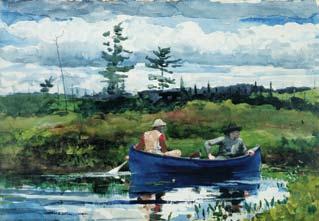
Semester’s end is marked by a class field trip to yosemite, where students are given artwork depicting parts of the Valley and instructed to find the exact spot from which the artist made the image.
On your next visit to yosemite, find the spot from which this 1929 photograph from Berkeley’s Weistlander vegetation project was taken. Or, find additional works of art depicting national parks at http://nature.berkeley.edu. Note what has changed and what has stayed the same. What was the artist attempting to capture? Did he or she succeed? Report your findings to friends and family over a campfire.
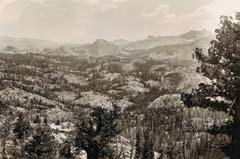


iI grew up in los Angeles. But I spent my summers in Stockholm, Sweden, where I could walk and take transit anywhere, even at night. When I began driving in l.A., I felt guilty pressing the gas pedal. I did it anyway, of course (though I tried to drive conservatively and carpool often).

I was keenly aware of the pollution I was emitting. l.A. consistently has the worst air quality in the nation. Vast quantities of vehicle emissions contribute to environmental health problems and global warming, and the city’s reliance on cars poses serious issues of accessibility, and equity as well.
I have always been interested in figuring out how to fix these problems, so I decided to write my honors thesis at Cal on public transportation in l.A. Originally, I conceived of the issue as a subway problem, or more accurately, a lack-of-subway problem. however, I quickly realized that the problem was bigger; a solution must address compounding factors to l.A.’s reliance on cars, such as parking policies, neighborhood zoning, and building designs not conducive to walking, biking, or transit.
Researching my thesis allowed me to approach this widereaching topic from multiple disciplines. I looked at economic incentives and disincentives and market-based controls, transportation-related policies, and city planning and architecture. I learned about the historical obstacles facing l.A.’s public transit. And I analyzed the city’s current plans to extend the rail system.
One part of the problem is parking: los Angeles has the highest parking coverage rate in the world, at 81 percent. (Compare that to 31 percent in San Francisco.) Parking lots are typically located at the front of stores, directly off the street. This is convenient for drivers, but detracts from the façade and
street beauty and makes it hard for foot and bike traffic to access stores. Ostensibly free or cheap parking helps make driving the preferred mode choice. however, consumers are unaware that they pay for their parking in the higher costs of their goods, creating market failure. We have to ask ourselves: why does los Angeles have the high minimum parking requirements that it does? What purpose do they serve, and are we satisfied with the results?
Things like parking lot size and location affect the way that we relate to the city, its streets, and our fellow citizens. I dove into the theoretical and philosophical questions that arise in contemplating a city dominated by single-person vehicles and parking. Class barriers are created when venues are only accessible via automobile. Personal vehicles separate the individual from the city. Public streets once functioned as vibrant meeting places, but have now become “vectors” for vehicles to travel from point A to point B. Random interactions are minimized, and city charm is lost.
If l.A. is to improve, we need to get people out of their cars. We can do this by creating spaces for people—not just cars—and by adding density to urban cores and making them walkable, bikeable, and transit-accessible. This will require more mixed-use and transit-oriented developments where housing, entertainment, and work sites coexist, and large amounts of parking are replaced with infill developments. In addition, subway lines will need to be extended, and “bus rapid transit,” designed to give buses the efficiency and appeal of light rail,
Frustrated with car culture, Daria Mazey, Conservation and Resource Studies ‘07, looks at the past, present, and future of Los Angeles transportation.
should be put in where appropriate. Finally, a comprehensive bike path network needs to be built. Biking is an under-valued, very viable option for l.A. in particular, given its good weather, health-conscious culture, and flat terrain. With supportive policies and comparatively little investment, this infrastructure could yield great results.
Possibilities like these reassure me that my hometown is not doomed. And if my research experience did nothing else, it impressed upon me the importance of consumer choices and demand. So, on a personal level, I have sworn off driving to work.
Perhaps that’s why my new job isn’t in los Angeles.
After graduating, Daria Mazey started a job in plan formulation with the U.S. Army Corps of Engineers in San Francisco. She will get experience and training in a number of federal environmental arenas. Her new office has a gym and locker room with showers, which will make it easier to bike and take transit to work.

Daria Mazey’s research synthesized economics, policy, and history—but to put her data in context, she also got behind the wheel, video camera in hand, to document the car-centric landscape of l.A. neighborhoods. Check out the narrated video at http://nature. berkeley.edu/breakthroughs.

eric Flowers, who is now chairman of the Haight Ashbury Free clinic’s board, was photographed as the clinic prepared to open a new, 19,000 square-foot facility in San Francisco’s Mission district. “Haight Ashbury almost sank,” says Flowers. “But it’s finally starting to move forward with significant strides.”

In November 2002, just months after being named to the finance committee of the haight Ashbury Free Clinic’s board of directors, Eric Flowers, Political Economy of Natural Resources ’90, learned that the nonprofit’s CFO had embezzled $773,000 over three years. Scandal ensued and the future of the clinic, which serves 18,500 patients each year, was in peril.

But the problem was broader than a single crooked executive. “Thirty-plus years of organic growth set the landscape for that kind of theft,” says Flowers. The critical tasks ahead were to clean up the books, recruit new talent, and create a more stringent management culture.
“The first three years were murder,” Flowers says. “haight Ashbury almost sank. But it’s finally starting to move forward with significant strides, and that’s rewarding after all the time and effort employees put in, all the pain they suffered.”
Though he holds an M.B.A., Flowers learned much of what he knows from his father, who started a mom-and-pop pharmacy in East Oakland in 1964. The family now runs five businesses, including Public health Service Bureau (PhSB), which administers AIDS drug assistance programs for California and Washington state. “We help the people who are serving the underserved by making their dollars go further,” explains Flowers, PhSB’s president and CEO. The family also runs a charity that strives to “bridge the gap” in AIDS drug funding by assisting people who aren’t eligible for state help. “In both the for-profit and nonprofit worlds,” Flowers says, “we want to take care of the most fragile among us.”
The company’s growth over the years has not been without its own challenges; theft within the company led Flowers to adopt a “trust, but verify” management philosophy. As with the situation at the haight Ashbury Free Clinic, good business practices ultimately benefit patients.
If all goes well, Flowers’ next move will be to expand PhSB’s work to Puerto Rico. “Their AIDS drug program has had fraud issues, and funding’s gotten frozen,” he says. “We’re working with them to modernize [their operation]... so that it will have quality control and will withstand audit.”
“We’ve heard from some people, ‘be careful in Puerto Rico.’ But if we turn our backs on them because they’ve had problems, we’d be hypocrites. People need our help.”
Flowers is focused on building a business that provide just that kind of help, well into the future. “The challenge, ” he says, “is to transition the business from what my dad started to an operation that will run long past him and me.”
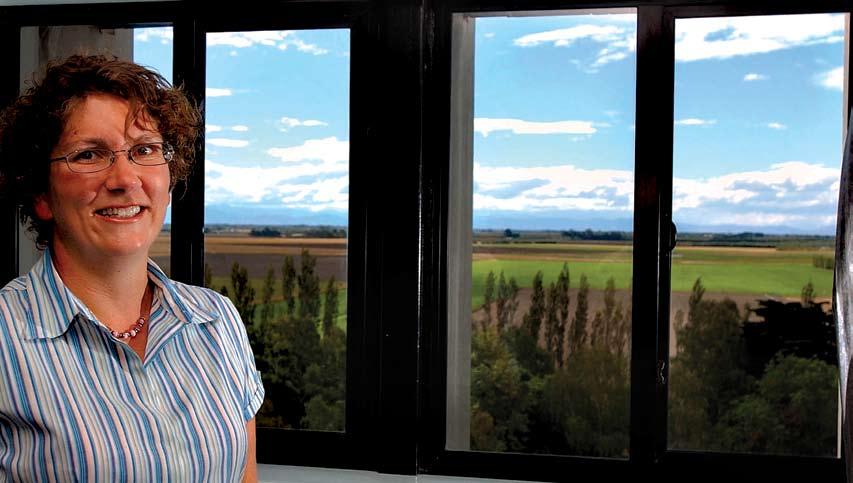 By Letty Brown
By Letty Brown
Upon filing her Berkeley Ph.D. in environmental science, policy, and management in 2005, Ann Brower landed a Fulbright Scholarship and set course for New Zealand, to study something that smelled a little fishy: an exercise in land use called “tenure review.”
Through tenure review, New Zealand’s government was moving farmers off highcountry tracts they’d leased for grazing, setting the land aside for conservation parks and reserves. In return, it was giving away low-lying valley land. Curiously, instead of the mere grazing rights they’d had before, the farmers were being granted full titles to their new lands, which were some of the most productive in New Zealand. Cash stipends were also included to further sweeten the deal.
Essentially, large amounts of public land (about 10 percent of the country) were
being quietly privatized. Though the process had been ongoing for 15 years, it had never received much attention. Then Brower arrived.
“I looked at it and said, wait a minute--I’m no economist, but I know that grazing rights are worth far less than development rights.” She started digging, collecting records and conducting interviews. “It was quite difficult to get people to talk to me; they knew better than I that this was radioactive.” She finally convinced an official to show her the purchase and sale prices, which had long been kept secret from the public. “When I first saw those economic spreadsheets, I said, ‘there’s a mistake here—these columns must be reversed.’” But in fact, the way the accounting went, farmers had been awarded a total of over 10 million USD in taxpayer money for the burden of assuming ownership of arable, salable land. Some of the land given to the farmers has been sold off for golf courses and villas.
Shortly after releasing her findings, Brower found herself on New Zealand TV and radio and in the newspapers, being asked to detail her uncovering of the “South Island land grab.” While many stories sputter out in days, this stayed in the news for months.
Meanwhile, the farmers are, in Brower’s words, “hopping mad.” They sent a 25page letter complaining of her to Fulbright. labeling her “an ignorant infection,” some have said they’d take it up with Gov. Schwarzenegger, who signed her Ph.D.
In the meantime, perhaps unsurprisingly, the entire tenure review enterprise has ground to a halt. The process is under intense scrutiny from New Zealand’s Minister of lands, and not a single deal has gone through since Brower’s research came to light.
Letty Brown is a Ph.D. candidate in the Department of Environmental Science, Policy, and Management, and is coordinating a half-million acre habitat conservation plan in Northern California.
Can a deadly virus like HIV be beautiful? Chicago-based artist
 hunter
hunter
O’Reilly, (née Gayle hunter) Plant Biology ’93, thinks it can. Both a geneticist and a visual artist, she brings these fields together in an attempt to explore the beauty she finds hidden within biological science.

One of O’Reilly’s most controversial collections, “Viruses are Beautiful,” features largescale digital prints of electron micrographs, on Plexiglas and colored using neon. In her treatment, intensely colored pathogens including influenza, Ebola, herpes, hIV, and rabies look more like colorful children’s toys than deadly viruses. “Most people associate the viruses with their physical effects, but have never seen them,” O’Reilly says. The paradox inherent in highlighting the beauty of these organisms is part of the message: “Just because something is beautiful does not make it good,” she says.
Some of the media O’Reilly works with are unconventional, as well. The glow-in-the-dark patterns on display in her “living Drawings” series, for example, used living, bioluminescent bacteria. Works such as Her Own DNA, which incorporates a double helix and shapes that represent O’Reilly’s own genetic makeup, were created by drawing living bacteria onto a nutrient-rich, Jell-O-like matrix. The original works were fleeting by nature: the glowing bacteria only live for two weeks.

Along with her work as a “bioartist,” O’Reilly teaches at the University of Chicago at loyola, and has created a unique course called Biology Through Art. The course introduces students not only to well-known artists such as Monet and Pollock, but also to more unusual artists such as Gary Schneider, a South African photographer famous for his artistic response to the human Genome Project called Genetic Self-Portrait. O’Reilly’s goals, she says, are to get students to see art where most people just see data, and to make learning biology more fun. “It’s interesting to integrate biology and art because it’s so novel,” she says. “People haven’t heard of this before.”
But the novelty conceals a deeper purpose. By exposing the public to aspects of science they wouldn’t normally consider, O’Reilly hopes to turn the perception of science as the sterile domain of erudite and begoggled geniuses to something that relates to everyday life. her art reflects a very human sense of wonder at the marvels of the natural world. And after all, she says, “Scientists are only human.”
In September, the University received the largest private gift in its history: $113 million from the William and Flora hewlett Foundation. This gift will provide endowment support to help close the funding gap between Berkeley and its elite private peers.
“Berkeley is the crown jewel of public higher education — not just in California, but in the country,” said Walter hewlett, chairman of the board of the hewlett Foundation. “The foundation’s grant represents our vote of confidence in a truly great institution.”
The vast majority of the gift comprises a $110 million challenge grant aimed at attracting matching funds to endow 100 new faculty chairs. With the match, the hewlett Challenge will raise $220 million. Endowed chairs are funds invested to provide financial support in perpetuity for faculty. They offer philanthropists the opportunity to support a field of academic endeavor that is of particular interest to them.
’62
Kurt Weinke, Ph.D., Plant Pathology, is retired and hopes to move to North Carolina by the end of 2009.
’75
Gary Grossman, B.S., Conservation of Natural Resources, has just published A Bone to Pick: Everyone’s Guide to Gourmet Venison Cookery. Information on the book can be found at www.negia.net/~grossman/cookbook.html.
’75
Chris Walton, B.S., Conservation of Natural Resources, lives in Eugene, Oregon. He is an orthopedic surgeon specializing in sports medicine, with a special interest in injuries to the knee. His professional group is completing an 80,000 square-foot office and surgery center called the Slocum Center. He enjoys Eugene because “it is a great place to enjoy the outdoors, minimize crowds, and enjoy a university influence.”
’81
Tom Larsen, B.S., Conservation of Natural Resources, and his wife Debbie Williams have committed their 12-year-old laptopcase company, Shoreline, to a path toward “green” materials. Distributed in over 500 retail stores nationwide, the cases will be made from recycled PET plastics and should start to arrive in the market in October. Larsen says the commitment makes Shoreline the first import bag brand to fully convert its product line from non-green to green materials. www.shorelinecases.com
Appointment to an endowed chair is a mark of high academic distinction for a professor. Endowed chairs are critical to recruiting and retaining top professors — the cornerstone of Berkeley’s excellence. While Berkeley’s private peers have the huge competitive advantage of offering higher salaries and greater research funding, endowed chairs will help Berkeley continue to attract the finest faculty.
Here’s how the challenge works:
· It will match, dollar for dollar, 80 gifts of $1 million each to endow 80 new, $2-million faculty chairs.
· It will also match, dollar for dollar, 20 gifts of $1.5 million each to endow 20 new $3-million distinguished chairs that span multiple academic disciplines.
Share your news! Submit class notes at http://nature.berkeley.edu/notes, or by e-mail to breakthroughs@nature.berkeley.edu.
’86
Yu-Chun Wang, M.S., Forestry and Resource Management, reports that he was recently surprised to find his photo on the Web from when he attended forestry camp in 1984. [Along with many more, dating back to 1967, at http://espm.berkeley. edu/summercamp/campfoto —ed.]
’90
Karen Frye, B.S., Environmental Economics and Policy, is now working for the San Francisco Public Utilities Commission (SFPUC) in their Bureau of Environmental Management. She oversees CEQA/NEPA documents and regulatory compliance for various projects.
’93
Beto Borges, B.S., Conservation and Resource Studies, obtained an M.B.A. in strategic leadership after graduating from UC Berkeley. After working in executive positions with Rainforest Action Network, Shaman Pharmaceuticals, Goldman Environmental Foundation, Aguirre International, and AdoptA-Watershed, he is now the director of the communities and markets program at Forest Trends. At Forest Trends, his work is to leverage payments or compensation for ecosystem services to benefit forest and rural communities in Africa and Latin America. Learn more about Forest Trends’ work at www.foresttrends.org and www.ecosystemmarketplace.com.
’96
Sylvia Busby, B.S., Conservation and Resource Studies, and her husband Bruce just had their first baby, a girl named Aiko. Sylvia has been working with the Nature Conservancy of California since 2005 as program coordinator of conservation science and planning.
’02
Alex Holton, B.S., Resource Management, sends his love to alumni of Forestry Camp from 2001. “I miss you guys.”
’03
Kaete King (Eisenmann), B.S., Environmental Economics and Policy, is working for the California North Coast Regional Water Quality Control Board. She works in the timber division, protecting water quality in watersheds north of the Eel River. She says she’s very happy with her job: “It’s a dream come true.”
’05
Michael Joseph, B.S., Molecular Environmental Biology, is excited to be working as an environmental compliance specialist for an environmental consulting firm called Belshire Environmental Services, Inc. He says, “Thanks to the terrific courses, as well as the wonderful advising that CNR offered me, I am well prepared for the work field.”
’07
Briana Kobor, B.S., Environmental Economics and Policy, works as a technical analyst for NRW & Associates in downtown Oakland. It is a small firm that does consulting work including economic, regulatory, and policy analysis. So far she says she’s really enjoying her job: “The work is challenging, varied, and extremely topical.” She’s currently working on a number of projects and learning very fast. In the future, she hopes to go to graduate school.
Honor Roll, July 1, 2006 through June 30, 2007 and Hilgard Society, 2006
The College of Natural Resources gratefully acknowledges the alumni, friends, foundations, and corporations listed below. Many thanks to all of CNR’s donors for their continued commitment and support. Gifts and pledges of $100 or more to any fund within the College, received during the ‘06-’07 fiscal year, qualify for the Honor Roll.
500,000+
Chez Panisse Foundation
250,000-499,999
East Bay Community Foundation
Group Health Community Foundation
Robert Wood Johnson Foundation
100,000-249,999
Dow AgroSciences LLC
Dr. Howard M. Goodman & Deborah S. Goodman
Gordon & Betty Moore Foundation
John H. Gross, ‘47
Kaiser Foundation Health Plan, Inc.
James R. Lugg, ‘56 & Marilyn G. Lugg
Iona Rockwell Main, ‘49 *
Dr. Gordon E. Moore, ‘50 & Betty Moore
The Overbrook Foundation
The Rosalinde and Arthur Gilbert Foundation
Matthew M. Winkler, Ph.D., ‘74 & Margaret A. Winkler
50,000-99,999
American Heart Association
Ecoagriculture International
KineMed, Inc.
Dr. Robert O. Nesheim
Palo Alto Medical Foundation Research Institute
Two Blades Foundation
W. M. Keck Foundation
10,000-49,999
Adelle Davis Foundation
Bayer CropScience LP
Phillip S. Berry & Carla G. Berry
Andrew S. Carothers, ‘98
George A. Craig, ‘39 & Viola Harris Craig, ‘39*
Du Pont De Nemours and Company
DuPont
Green Diamond Resource Company
Professor W. Michael Hanemann & Mrs. Mary E. Hanemann
Robert C. Hoerr, ‘54* & Florence Hoerr *
Kaiser Foundation Health Plan
Professor Angela
Capobianco Little, ‘40
George A. Miller, ‘61 & Janet A. McKinley, ‘61
New Place Fund
Nisus
Bruce H. Olson & Joann D. Olson
Paramount Farms, Inc.
Pebble Beach Company
Pedro Silva & Helena R. Pires
Rhonda S. Purwin, ‘77
Professor Vincent H. Resh & Cheryl Haigh Resh, ‘91
Russell L. Rustici, ‘48
Sierra Foothills Audubon Society
Summit Brokerage Services, Inc.
Syngenta Crop Protection, Inc.
The San Francisco Foundation
Whitmire Micro-Gen Research Laboratories, Inc.
5,000-9,999
Raymond C. Carrington, ‘53
Clark Pest Control
Edwards Trust
Forest Vegetation Management Conference
Geomar Foundation
Ann E. Harrison, ‘82 & Vincente M. Madrigal
Sara Schultz Hofmockel, ‘77
Dr. Herbert M. Hull, ‘46 & Mary M. Hull
Land Institute
Foster E. Murphy, ‘48 & Murphy-Payne Charitable Trust
Sacramento Audubon Society
Safari Club International, Golden Gate Chapter
John Scharffenberger, ‘73
Professor Arnold M. Schultz
Shasta Wildlife Conservation Foundation
Dr. Richard B. Standiford, IV, ‘78 & Judy L. Neasbitt-Standiford, ‘78
Suterra LLC Oregon
John L. Swanson, ‘38
Thermapureheat
Wells Fargo Foundation
2006 Hilgard Society donors, noted in italics, have given $250 or more to the Berkeley Fund for Natural Resources and the Don Dahlsten Outreach Fund, CNR’s primary funds that support virtually all areas within the College.
Donors belonging to both the Honor Roll and Hilgard Society are noted in bold italics. Gift amounts reflect the greater of the Honor Roll or Hilgard Society giving and do not reflect a combined total.
2,500-4,999
Arysta LifeScience North America Corp
Binational Agricultural Research & Development Fund
California Pistachio Commission
John L. Casazza, ‘77 & Dolores Casazza
Cerexagri, Inc.
Paul G. Cheng & Nai-Yi Cheng
Janet C. Dahlsten, ‘71
Frederick L. Ehrman, ‘27*
Robert E. Gilbert, Sr., ‘47 & Beverly S. Gilbert
Donald L. Haid, ‘97 & Hallidie G. Haid
Paul W. Hartloff, Jr., ‘55 & Felicie Fitzgerald Hartloff, ‘57
Kathleen Ohlson Hartzell, ‘72 & Christopher Hartzell
Constance M. Hempel
Sabrina A. Lahiri-Field, M.D., ‘88 & Dr. James A. Field
Douglas S. Lipton, ‘91 & Cynthia E. Daniel
Michael D. McKaig, ‘70 & Kathryn A. O’Neal, ‘76
Scott R. Muldavin, ‘79 & Susanne I. Ragen, ‘80
Dr. Robert T. Porter, ‘40 & Mary K. Porter
Kennedy P. Richardson, ‘71 & Kathleen M. Richardson
San Luis Obispo County
Community Foundation
Ruth M. Schubert
Joel R. Singer, ‘79 & Enza Cancilla
Slater’s Pest Control
John F. Swift, ‘76 & Kirsten Swift VentureStar, Inc.
James P. Vokac, ‘76 & Stacey T. Baba, ‘77
William L. Woods, III, ‘73 & Kathleen C. Woods
Timothy A. Woodward, ‘82 & Margaretta Y. Woodward
1,000-2,499
Harry C. Abraham, ‘43
Anthony Amend
Cyril J. An, ‘86 & Lucia A. Han
Burton A. Anderson, ‘49
Richard H. Beahrs, ‘68 & Carolyn Pardee Beahrs, ‘67
Bechtel Group Foundation
Stephen P. Bradley, ‘60 & Barbara R. Bradley
Steven S. Bremner, ‘73 & Kathleen K Bremner
Mary L. Brutocao
James A. Burris, ‘41 & Lois L. Burris, ‘48
Nancy Dawson Christensen, ‘50 & Deal Christensen, Jr.
James H. Cooney, Jr., ‘66 & Mary J. Cooney
Dr. Thomas A. Daane, ‘51 & Lois Marshall Daane, ‘52
Donald W. Davis, ‘43 & Leona Erickson Davis
Franklin E. Dillard, Jr., ‘47 & Millie M. Dillard
J. Michael Doyle, ‘66 & Corinne Groper Doyle, ‘67
Fidelity Charitable Gift Fund
Susan Bolger Foerster, R.D., ‘69 & Dr. James M. Foerster
Professor Louise P. Fortmann & Emery M. Roe, ‘88
Jack B. Fraser, ‘77 & Maribel Helena Fraser, ‘76
Dean J. Keith Gilless & Janice W. Gilless
Dr. Orville J. Golub, ‘44 & Ellina Marx Golub, ‘39
Robert S. Grether, ‘47 & Sally Moffatt Grether, ‘45
Nelletje Groenveld, ‘84
Kathleen G. Gundry, ‘74 & William B. Maly
Raymond E. Helm, ‘51 & Ingeburg Helm
Gerald Hillier
Gail Hoffman
Stephen L. Hurst, J.D., ‘78
Osamu Ikeda, O.D., ‘76 & Ruth Sugiyama Ikeda, Ph.D., ‘82
Donald D. Jackson, ‘50 & Dorothy Rodden Jackson, ‘49
Jewish Federation of Cleveland
John M. Kemp
Jason T. Kibbey, ‘01 & Elizabeth Baker
Dr. John Lang
Douglas R. Leisz, ‘50 & Marian A. Leisz
James D. Levine, ‘78 & Angela M. Jacobson
Paul W. Ludden & Linda Ludden
Nancy Kresser Lusk, ‘64 & Dr. Michael H. Smith, ‘73
Natalie H. Magy
Tad Mason, ‘79 & Norma Mason
Professor Carolyn Iltis Merchant
Nancy Merrell
Dr. Richard G. Millikan, ‘69 & Marlene Licht Millikan, ‘67
Andrew G. Morse, ‘01
David E. Moser, ‘81 & Barbara Walsh Moser, ‘80
E. Robert Munsey, ‘69 & Kathy Munsey
Peggy Lockie Navarra, ‘70 & Anthony J. Navarra
Northrop Grumman Foundation
David C. Nuban, ‘82
John C. Adams & Deborah L. O’Grady
Oil Transactions LLC
Dr. Roderic B. Park & Catherine Bromage Park, ‘66
Pesticide Action Network
Donald W. Raymond, ‘64 & Barbara A. Raymond
Professor Jeffrey M. Romm, ‘64
Bernice D. Schwabacher
Sue W. So, ‘93
Dr. Jeffrey P. Solar, ‘74 & Rosalyn R. Furukawa, ‘75
Dr. John F. Stollsteimer, ‘61
The Dow Chemical Company
The Jason Family Foundation
Mark E. Triebwasser, ‘71
Yuk Lun Tsang, ‘74 & Hai Y. Tsang
Theresa Y. Tsao
Henry Vaux, Jr., ‘62
Weyerhaeuser Company Foundation
Russell O. Wiese, ‘89 & Megan Y. Wiese
Christopher R. Woolf, ‘85 & Sarah Woolf
Stuart Woolf, ‘82 & Lisa Coulter Woolf, ‘82
Dr. C. Spencer Yost, ‘76 & Ana E. Estrada-Yost
500-999
Maureen Larrowe Jordan, ‘83
AT&T Foundation
Annual Reviews, Inc.
Daniel M. Cotton, ‘90 & Diane J. Appel, ‘85
Kathryn Moriarty Baldwin & Gregory P. Baldwin
James M. Battagin, ‘73
Stephen L. Beck, ‘66 & Terry Duffy Beck, ‘65
Dr. John C. Beghin, ‘88
William R. Bentley, ‘60 & Ann E. Wilhelm
Borite Termite & Pest Treatments Corp
California Dietetic Association
Richard D. Carson, ‘58
Carville Sierra, Inc.
Philip P. Carville, ‘62 & Julie Stauffer Carville, ‘72
Barbara Yee Chan, ‘71
Nancy C. Clark, ‘76
Dr. James L. Clayton, ‘65
Dennis G. Clemens, ‘68
Gerald R. Conley, ‘63
Mary Fulton Cuthbertson, ‘49
Dr. Richard J. Dare, ‘79
Robert V. Dickinson, ‘63 & Sylvia A. Dickinson
Daina Dravnieks Apple, ‘77 & Dr. Martin A. Apple, ‘68
Dr. Robert A. Ewing, ‘67
Michael George
Bryan Gingg & Beverly Gingg
Mary Beahrs Grah, ‘39
Carole Johnson Gray, ‘82
Gene Forsburg, ‘75 & Kass Green, ‘74
Harriet L. Hamlin
Harvard University
George W. Heller, ‘42
Dr. Suzanne Hendrich, ‘82
Robert E. Heyden, ‘51
Scott W. Horngren, ‘78
Bridget Taylor Huntington, ‘46
Leroy A. Jebian, ‘64 & Winifred Camp Jebian, ‘65
Johnson & Johnson Family of Companies Foundation
Kay Lewis Ranches, Inc.
Kennedy Associates, Inc.
Killroy Pest Control, Inc.
Joanna Renetzky Kingham, ‘39
Dr. Peggy Lemaux & Clark D. Lemaux
Lloyd Pest Control
Donald J. McGinty, ‘83 & Barbara A. Lane
Dr. Elmer L. Menzie, ‘61
Kenneth D. Meyer, ‘66 & Linda Meyer
Philip B. Nelson, ‘87 & Kerstin Nelson
Newport Exterminating
David W. Niesen, ‘81
Laura R. Oftedahl
Professor Dara J. O’Rourke, ‘95 & Cathy H. Cha, ‘96
Mark S. Patt & Beverly Pollens
John E. Pehrson, Jr., ‘51 & Mary E. Pehrson
Eran Pichersky, ‘80 & Liza C. Pichersky
Michael J. Powers, ‘95
Robert L. Rennie, Jr., ‘62 & Ora Mae Rennie
William H. Seaman, ‘39
Dr. Scott S. Sibbett, ‘79 & Karen Hansen Sibbett, ‘79
Dr. Alan G. Stangenberger, ‘65
Dr. William C. Stewart, ‘86
Thomas W. Sutfin, ‘76
Professor Dennis E. Teeguarden, ‘58 & Sally A. Teeguarden
Alyssa Gong Tennenbaum, ‘82 & Mark S. Tennenbaum
Thomas Family Trust
David Cooke Thomas, ‘82 & Tina Regan C. Thomas, ‘83
Dr. Walter C. Tim, ‘48 & Kay Lewis Tim, ‘59
Janice Untereiner
John M. Van Hooser & Vida L. Van Hooser
Hugh E. Wilcox, ‘38 & Betty Wilcox
Anthony L. Chen, ‘90 & Shirley S. Wong-Chen, ‘89
Richard C. Worden, ‘86
250-499
Dr. Susan Spiller
Acquistapace ‘67 & James S. Acquistapace
Thomas D. Amesbury, ‘78
Amgen, Inc.
Dennis Baldwin & Gail Baldwin
William M. Beaty, ‘38 & Georgia F. Beaty
Michael B. Beeman, ‘67
Bill B. Bennett & Fran R. Bennett
Professor Rolf W. Benseler, ‘57
Kris G. Bonner, ‘76 & Deborah A. Lyon, ‘75
Frances Bowman, ‘70
Thorley D. Briggs & Gloria B. Briggs
Dr. Harold A. Love, ‘88 & Dr. Diana M. Burton, ‘86
Garth W. Casaday, ‘77 & Patricia A. Baker-Casaday, ‘78
Central New York Community Foundation, Inc.
Dennis W. Coulter, ‘79 & Lauren B. Appling
E. Patrick Creehan, M.D. & Yvonne Creehan
Elizabeth Fordyce Cuff, ‘80
Professor Emer. Howell V. Daly, Jr. & Barbara B. Daly, ‘61
Michael Davis & Kate Davis
Randy L. Davis, ‘76
Dr. Helene Roberts Dillard, ‘77 & Victor A. Dillard, ‘76
Nancy A. Drake
Janet E. Eadie, ‘81
Tad T. Egawa, ‘89
Pamella A. Emberley, ‘90 & William D. Emberley
Marian Koyama Endo, ‘78 & Dean K. Endo
Duncan Fallat, ‘84
Professor Lewis J. Feldman, ‘67
Wendy Gardner Ferrari, ‘66 & Burke Ferrari
Dr. Susan C. Flores, ‘77
Russell E. Forsburg, ‘78 & Kathleen M. Forsburg, ‘78
Gina Frierman-Hunt, ‘77 & Paul T. Hunt
David J. Ganz, Ph.D., ‘93
Christina M. Getz, ‘98
Lawrence J. Giles, ‘67
Rudolf Glauser, ‘67
Un H. Har, ‘95 & John R. Kao
Andrew T. Hass, Jr., ‘46 & Annette Gimbal Hass, ‘46
Robert T. Hatamiya, ‘56
Douglas W. Hayden, ‘57
Dr. Bill F. Hieb, ‘59
Ralph D. Hodges, Jr., ‘46
Kenway Hoey & Jeanne G. Hoey
George R. Holden, ‘47
Dr. Rickey A. Hopkins, ‘90
Bruce Hostetler
Wan-Tsung Wang & Lu-Jen Hou
Professor Lynn Huntsinger, ‘83 & Professor Paul F. Starrs, ‘84
Grace Ieong
Innovative Pest Products
Richard L. Jones, ‘41
Roger G. Jones, ‘39
Robert F. Kane, ‘73 & Marla Palty Kane, ‘90
A. Arlene Kasa, ‘59
Mary Arvanitelis Kasaris, ‘77
Julia Epley Klee, ‘80 & Howard Klee
Dr. David J. Larson, ‘76
Donald T. Lauer, ‘63 & Carol Millinich Lauer, ‘63
Robert L. Leatherman, Jr., ‘49 & Inez N. Leatherman
Clifford A. Lee, O.D., ‘84 & Edna F. Lee, O.D., ‘86
Yong L. Lee, M.D., ‘81
Lockheed Martin Corporation
Robert T. Martin, ‘51
Marylin Mino Mathews, ‘45
Richard J. McCann, ‘81 & Ellen Morattie
Dr. Mitchel P. McClaran, ‘78
Dr. Ann McGowan-Tuskes, ‘80
Dr. Charles I. McNeill, ‘75 & Joan Falkenberg McNeill, ‘73
Jason J. Moghaddas, ‘95 & Emily E. Greinke, ‘95
Jerry Murphy
Dr. Suzanne P. Murphy, ‘84 & William E. Murphy
Dan S. Nakamura, ‘80 & Doreen Y. Nakamura
David Nielsen, ‘84 & Catherine R. Nielsen
Ronald Okimoto, ‘79
Susan R. Orbuch, ‘86 & Jim Gilbert
Stanley A. Palmer & Wanda P. Palmer
Edison S. Paw, ‘77
Brian R. Payne, Ph.D., ‘61 & Almuth Fahrenbach Payne, ‘61
Professor Nancy L. Peluso & William D. Langbein
Pestec
Dr. Thomas T. Lawson, ‘88 & Dina L. Rasor, ‘78
Joshua A. Reilly, ‘84
Robert J. Reinhard, ‘86
Thomas L. Richard, ‘78
Alfred B. Romero, Jr. & Abigail D. Romero
Sandeep Sacheti, ‘97
Ronald Salz, ‘87
Roger Samuelsen, ‘58 & Jeane Stewart Samuelsen
Rose M. Sarquis
Henry M. Schacht, ‘36
Eliana C. Schultz, ‘78 & David Schultz
Tom G. Schwan, ‘83
Science Applications International Corporation
Gail M. Simpson, ‘87
Douglas M. Sinton, Ph.D., ‘73
Gordon J. Smith, ‘76
Dr. Lionel W. Sorenson, ‘50 & Katherine Fornoff Sorenson, ‘51
Dr. Harvey J. Stein, ‘91 & Irina G. Stein, ‘85
Peter A. Stine, ‘75
Michael C. Stroud, ‘69 & Georgia J. Stroud
Michael T. Sullivan, ‘73 & Mary Mulligan Sullivan, ‘75
Robert D. Taylor & Rose L. Taylor
Jeanne Heintz Tomascheski, ‘77 & Daniel J. Tomascheski
Mark L. Travis, ‘88
Raul N. Tuazon, ‘84 & Mary Bartoloni Tuazon, ‘84
James S. Ukegawa, ‘83
Dr. Thomas W. Von Geldern, ‘84 & Cynthia L. Skrukrud, ‘87
Dr. Leslie A. Wanner, ‘90
John Westoby & Lynn Westoby
Michelle M. Whitman, ‘07
Professor David Winickoff
Dr. Eva K. Wollenberg, ‘80
Tim T. Wong, ‘61 & Effie L. Wong
Gary L. Wyke, ‘72
Lance K. Yokota, ‘82 & Kathleen S. Fong-Yokota
Edmund Y. Young, ‘98
Diane S. M. Yu, ‘96
Devon Zagory, Ph.D., ‘74
Abbott Laboratories Fund
Dr. Dennis J. Aigner, ‘59
Charles H. Almestad, ‘76 & Mary A. Almestad
John D. Andrews, ‘52 & Joan Gumbrecht Andrews
Dr. Richard A. Arnold, ‘80 & Debra J. Arnold, ‘78
Daniel E. Averill, ‘68 & Marie Averill
Elizabeth M. Bahn, M.A., ‘92
Rowan J. Baker, ‘88
Steven S. Balling, ‘74 & Carolyn Sorensen Balling, ‘74
Teri Moriwaki Banka, ‘77 & William J. Banka
James C. Bates, ‘58
Coleman D. Bazelon, ‘89 & Patricia F. Bazelon
Kenneth M. Begun, ‘81
William S. Berry, ‘64 & Sandra Winje Berry, ‘63
Lynn R. Biddison, ‘51 & Patricia Baldwin Biddison, ‘50
Biomed, Inc.
Bio-Pest, Inc.
Marian Saeman Bleeke, ‘84
Norman B. Bliss, ‘67 & Melanie Knisely Bliss, ‘68
Dr. Rolf R. Koford, ‘79 & Dr. Bonnie S. Bowen, ‘78
Susan B. Brodahydorn, ‘77
Emma C. Brown, ‘98
James K. Brown, M.D. & Letitia U. Brown
James W. Bruner, Jr., ‘70
Steven F. Brye
Stephen P. Bundy, ‘77 & Ann E. Bundy, ‘77
Dr. Gary T. Burtless & Elise K. Bruml
Daniel Cahn, ‘80 & Carolyn C. Cahn
Professor Emer. Leopoldo E. Caltagirone, ‘60
Lawrence D. Camp, ‘71 & Constance A. Camp, ‘71
Matthew R. Campbell, ‘85
Harold C. Appleton, ‘76 & Patricia Canfield Appleton, ‘75
Clifford G. Carlson, ‘52 & Georgia Carlson
Tay H. Carpenter, ‘04
Ruth Woolson Catlin, ‘77 & James L. Catlin
*Deceased
William F. Chamberlain, ‘43
Chester C. Chan, ‘49 & Annie Foon Chan, ‘54
Merele D. Chapman, J.D., ‘69
James W. Charlton, ‘38 & Helen M. Charlton
Richard H. Chen & Anna Yau Chen
Louis K. Cherin, ‘38
Jason G. Chroman, ‘90 & Elizabeth Chroman
Coastside Termite & Construction
Andrew S. Coblentz, ‘79
Dr. Richard S. Colman, ‘70
Todd G. Cooper, ‘93
John V. Cosseboom, ‘81
Laurence R. Costello, ‘80
Timothy R. Costello, ‘80 & Nicola S. Costello
Dr. Patricia A. Crawford, ‘72
Dr. Clytia Montllor Curley, ‘85
Cypress Termite Construction Company
Kathleen McCowin Dal Bon, ‘72
Frederick J. Dau, ‘90
Barbara Gross Davis
Gregory A. de Haaff, ‘96
David E. De Laveaga, ‘75 & Sharon H. De Laveaga
Carmen D. Deere, ‘78
George H. Dekay, Jr., ‘42 & Barbara Root Dekay, ‘42
Diane M. Demee-Benoit, ‘81 & Daniel S. Benoit
Thomas R. Donohue
Michael G. Donovan, ‘06
Matthew E. Doty, ‘84
Edison International
Don M. Eisenberg, ‘75
Thomas M. Eklund & Roberta G. Eklund
Claire L. Englander, ‘89
Ryan O. Enright, ‘92
Entomology Special Events Committee
Ara K. Erickson, ‘00
A. Elizabeth Erman, ‘62
Marcelo C. Espiritu, ‘03
Yvonne F. Everett, ‘87
Andrew T. Fagan, C.F.A., ‘78 & Eileen D. Fagan
Diana Fish
Professor Anthony C. Fisher & Margaret A. Bentson
Fisk Termite Control
Eric A. Flowers, ‘90 & Susan E. Flowers
Jane Flueckiger
Foresters Co-Op
Jacob M. Frankel, ‘40
Daniel H. Frankenstein, ‘04
Daniel F. Freedman, ‘04
Harold G. Friedman, ‘69
Geraldine Wakiji Furuzawa, ‘65 & Richard Furuzawa
Thomas H. Gaman, ‘72
Dr. James S. Gerik, ‘84 & Martha Gerik
Michele Marchese Gibbs, ‘74
Vinay K. Gidwani, ‘96 & Divya Karan
Jerry J. Goldstein, ‘66
Luz A. Gong, ‘87
Donald R. Gotthold, ‘48 & Mary McGarr Gotthold, ‘61
Mary Aldrich Graham, ‘46*
Norman E. Graham, ‘41
Ryan M. Gregoire, ‘94
Lorna MacDonald Groundwater, ‘91
Joel P. Haggard, ‘79
Heidi Stettler Hagler, ‘82
Mark W. Hamlin, ‘77 & Gayle Erbe-Hamlin
Mohamad J. Hamzehinejad & Roza Hamzeheinejad
Art C. Harwood & Rebekah L. Harwood
John H. Hastings, ‘47 & Jeannette W. Hastings
Dermot J. Hayes, ‘86 & Caroline Hayes
Anne Delaney Heissenbuttel, ‘75 & John F. Heissenbuttel
Russell K. Henly, ‘93
Irene Hepps, ‘82 & Robert B. Hepps
Lisa L. Heschong, ‘73 & Douglas E. Mahone
Hines Pest & Weed Control
William P. Hoffman, ‘42 & Louise Wylie Hoffman, ‘41
George R. Hooper, ‘42
Carol A. Hudson, ‘85
William B. Hull, ‘80
T. Gordon Hum, D.D.S., ‘80 & Rosalyn S. Hum
Kathleen Hunt, ‘80
Intel Corporation
Arthur E. Isensee, ‘42 & Maurice Isensee
Karin A. Jacobson, ‘77 & Robert R. Seeman
Douglas M. Jarvis, ‘98
Judith D. Jennings, P.E., ‘77
Kenneth R. Johnson, ‘42
David E. Jones, III, ‘78 & Dianne S. MacDaniels
David R. Just, ‘99
Scott T. Kain, ‘79 & Linda B. Kain
Wayne T. Kammerer & Karen D. Kammerer
Kampp Family Trust
William F. Kampp, ‘56 & Claudia Speetzen Kampp, ‘57
Samuel T. Kaneko, ‘49 & Jean K. Kaneko
Mark A. Keller & Lori L. Keller
Allison C. Kelly, ‘06
Betty Courtright Keogh, ‘41
Uheng Khoo, ‘47
Doh J. Kim
George Kitazawa, ‘40
John J. Kordic, ‘82 & Nevenka P. Kordic
Kenneth Kung & Philomena King Kung
Benjamin T. Laflin, Jr., ‘47 & Patricia Baker Laflin, ‘49
Dr. Gary A. Lamberti, ‘83
Dr. Ruth E. Sherman & James P. Lassole
Terry M. Laydon, ‘69 & Mrs. Bobbi Laydon
Cuong D. Le, ‘00
Norma L. Lee, ‘53
Lehman Brothers, Inc.
Robert J. Lenahan, ‘70
John T. Lerch, ‘72 & Ms. Cathi L. Lerch
Robert Linderman
Dr. Cheng Liu, ‘96 & Peiqi Liu, ‘97
Hong Liu, ‘05
Susan S. Lo, ‘88
R. Dennis Lund, ‘63 & Mrs. Lynda K. Lund
Lynn R. Biddison Revocable Trust
Lee M. MacLean, ‘64 & Susan Craig MacLean, ‘63
Tia Welch Maerz, ‘80
Judith Smith Malamut, ‘83 & Mr. John Malamut
Scott S. Manhard, ‘76
Michael J. McCaffrey, ‘69 & Georgia L. McCaffrey
John K. McCall, ‘66 & Sandra Robbins McCall, ‘66
Christin Church McCollum, ‘74 & Mr. Stephen B. McCollum
Gilbert D. McCollum, Jr., ‘58
Elizabeth J. McCosh-Lilie, ‘68 & Mr. Lyle E. Lilie
Janet B. McDonald, Ph.D., ‘74
Lawrence Tan & Genevieve McGee
Marian V. Merrill
Harvey M. Michaels, ‘83 & Gloria E. Helfand, ‘88
Dr. Katsuko Mizumachi
Dr. Steven G. Montoya, ‘84
Donna Rich Moody, ‘70
Andrew R. Moore, ‘83 & Mrs Genevieve M Moore
Morales Extermination Company, Inc.
Wesley N. Musser, ‘74 & Mrs. Lynn M. Musser
David J. Nano, M.D., ‘77 & Tina J. Powell-Nano, ‘78
Joseph A. Naya, R.P.F., ‘94
Philip E. Nemir, ‘69
Diana Nguyen, ‘04
Kirsten A. Nielsen, ‘93
Clarence T. Nihei, ‘59 & Evelyn H. Nihei
Dr. John N. Nishio, ‘85 & Sandora J. Nishio
Norcal Mutual Insurance Company
Judith A. Olney, ‘79
Cassandra L. O’Neill, ‘87
Joseph J. Paik, ‘00
Janice Slater Parker, ‘46
Jason R. Patrick, ‘94
Sonia Pena, ‘98
Piyasena C. Perera, ‘83 & Natsuko S. Perera
Philip G. Pierpont, III, ‘67 & Lynne Pierpont
Roger L. Pollak, ‘83
Wee Y. Pong
Premise Keepers Pest Solutions
Helen Kelley Pressley, ‘73 & Jim D. Pressley
Benjamin Puttler, ‘55
Dr. Klaus W. Radtke, ‘81 & Yoshiko Radtke
Ronald A. Ratto, ‘73 & Catharine Haden Ratto, ‘81
Matilda Remba, ‘85
Donald L. Reukema, ‘53
Richard & Clare Lesser Family Foundation
James A. Rinehart, ‘65
Dale A. Roberts, ‘74 & Katharine E. Roberts
Deborah Hughes Robertson, ‘80
Alexis Wilson Robinson, ‘93 & Benjamin J. Robinson
David Rosenberg
Deborah A. Rudnick, ‘03
Antonio Salcedo & Lilia Salcedo
Dr. Michael C. Samuel, ‘82 & Dr. Jane E. Martin, ‘87
Edwin H. Satterthwaite, Jr. & Ruth C. Satterthwaite
Blake A. Schaefer, ‘00
Dr. Sara J. Schmidt, ‘81
John C. Schuyler, ‘78 & Priscila S. Franco
Dr. Julie E. Faisst, ‘73 & Mark S. Schwartz, ‘69
Aloha Ohm Seyman, ‘45
Frederick M. Shanks, ‘53 & Catherine Rhorabough Shanks, ‘53
Gwynne H. Sharrer, ‘39 & Helen Stahle Sharrer, ‘40
Wayne Simonson, ‘62 & Jaqueline Simonson
Arthur J. Slater, ‘74 & Judith K. Slater
Lawrence J. Slatkin, ‘83 & Lisa Furman-Slatkin
Jacqueline C. Smith, ‘77
Society Of American Foresters
Randolph L. Sperry, ‘77
Jill E. Stavosky, ‘76 & Michael Nicholson
John W. Steggall, ‘96 & Martha Quenon
Col. Quentin C. Stokes, USAF (Ret.), ‘49 & Helen Marie Youngberg Stokes
Marjorie Menoher Sutton, ‘53 & Harold G. Sutton
Ron Takai, D.D.S. & June Takai
John W. Thomas
Lana T. Tietjen, ‘76 & Paul B. Tietjen
Carlos Torres-Verdin, ‘91 & Laurel Trevino-Murphy, ‘88
E. Alison Tribble, ‘99
Townson Tsai, ‘92
UBS
Ikhyak Ulumudin
Louis M. Vasconi, ‘86 & Victoria S. Vasconi, ‘87
Connie L. Wade, ‘75 & Richard G. Wade, ‘76
John J. Waelti, ‘67
Brian E. Walgenbach, ‘86
David J. Warner, ‘76 & Suzanne Deutsch Warner, ‘78
Steven D. Washburn, ‘79
Professor William E. Waters
Winston I. Way & Jenny Way
Professor Clarence J. Weinmann, ‘50 & Carol L. Weinmann
Mary P. Wells
Allan J. West & Joyce C. West
Brett A. White, ‘82
Dr. Jennifer Meux White, ‘67 & Dr. Marshall White
Rose A. White, ‘68
Linda C. Whitehand, ‘66
Duane C. Wildenradt, ‘76 & Melinda L. Kovats
Donna B. Wolfe, ‘92
Edward S. Wong, ‘48 & May L. Wong
James T. Wong & Florence M. Wong
Hendrick Wong, ‘83
Lonnie Yee Wong, R.D., ‘71 & Wilton Wong
Barbara A. Wood, M.D., ‘68
Professor David L. Wood, ‘60 & Caroline W. Wood, ‘85
Diane Wayne Woods, ‘75 & Barry K. Woods
John M. Wray, ‘79 & Sheila N. Wray
Kay Yamagata
John E. Yoakley, ‘81
Nishka M. Yudnich, ‘61
Linda M. Zangwill, ‘80
Jeffrey D. Zimmerman, ‘80 & Sabrina S. Simpson, ‘80
Dr. Robert L. Zuparko, ‘75 & Carolynn Harvey Zuparko, ‘75
After graduating with a B.S. in Environmental Economics and Policy last spring, Mayra Ceja had a world of options. She chose to pursue an opportunity especially close to home, and landed a newly created job in CNR’s development office. Breakthroughs up with 22-year-old Ceja to find out what it’s like to go from full-time student to full-time fundraiser.
QSo much for greener pastures. Why did you decide to stay in Berkeley?
As a student I was really involved in the Cal community. I loved working as a counselor for CalSO, the orientation program for new students, and I loved my sorority, Phi Nu Xi, which is specifically dedicated to community service. The opportunity to start my career here and stay a part of the CNR community was a pretty easy decision. And believe it or not, fundraising for the College is something I really believe in.
QWhat sparked an interest in fundraising?
I worked part time in the Dean’s Office all through school as part of my financial aid package. So I was especially aware of the amount of resources and funding undergrads get, and how much of that comes from donors. The majority of the resources that I used as a student came from people who believed in the importance of giving back. hopefully, now I can help students have as great of an experience at CNR as I did.

I help the development officers coordinate and prepare presentation materials for meetings with prospective donors. I also conduct a lot of research, analyze data, pull reports from our database, and help coordinate events.
QWhat have you learned about alumni giving that surprises you?
The most surprising thing has been the difference that even one donation can make. For instance, I found out that if you look at gifts under $1,000, the average donation this past year was $179. That’s not a fortune, but it is a real, meaningful commitment. It means that people really care about supporting this place, and I think that’s amazing.
QWhat’s one thing your fellow recent grads should know about alumni giving?
First of all, after graduating, turning around with a handful of money for UC Berkeley was not something that crossed my mind. I mean, I’m just getting started in my career, and it’s easy to feel like whatever small contribution I could actually afford wouldn’t make a difference. But now I’ve seen firsthand that even small donations add up, and they fund the kind of things that make the College of Natural Resources one of a kind—things like the student resource center and CNR’s awesome research program, SPUR.
QWhat percentage of alumni stay connected to Cal?
I believe that most alumni tend to find their way back to this campus, whether it’s two weeks after graduation or five years down the road. There are so many ways to stay connected—giving back is just one of them. you might go to a football game, or make some sort of business connection with a fellow alum. Who knows, you might even come back and get a job here some day. The point is it’s a community—and it’s one that I’m really proud to be a part of.
Professor James Bartolome’s research group wants to know how grazing and fire have changed California’s savannas and grasslands, and what that might mean for conservation. their results have shown that livestock grazing and prescribed fire can actually enhance native plant recovery. here, Long Beach-based photographer David schmitz captures the Bartolome group in the field at Vasco regional Preserve near Livermore, California.
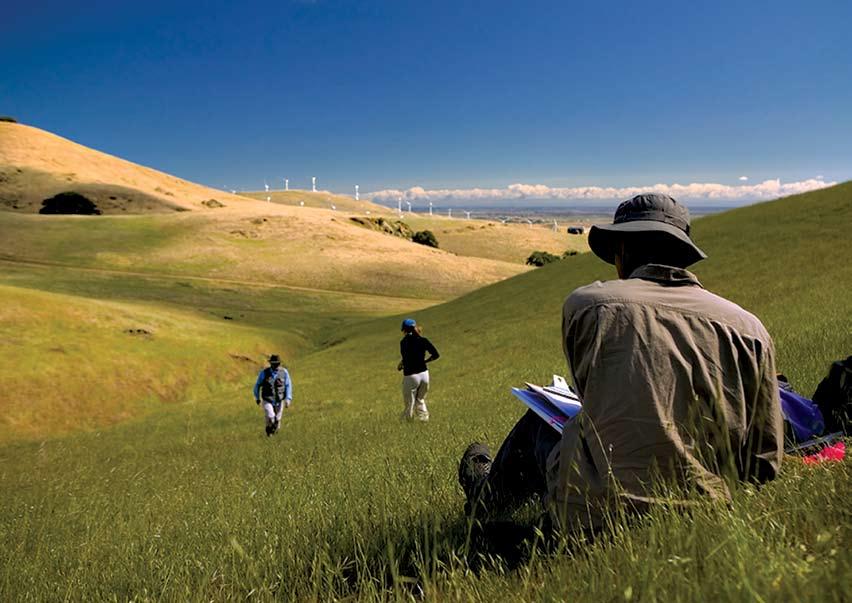
Breakthroughs photo contest
Congratulations to Darrell lee, whose baby crab photo (see page 1) was featured in the Winter 2007 issue of Breakthroughs
Submit your photo at http://nature.berkeley.edu/photo.
If we publish it on the Back Page, we’ll thank you with a giant, 4-GB memory card for your digital camera.

